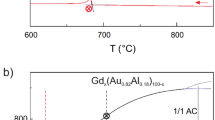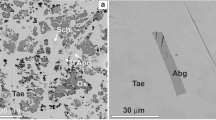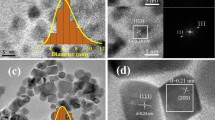Abstract
There are recent reports of weak ferromagnetism in graphite1,2 and synthetic carbon materials3 such as rhombohedral C60 (ref. 4), as well as a theoretical prediction of a ferromagnetic instability in graphene sheets5. With very small ferromagnetic signals, it is difficult to be certain that the origin is intrinsic, rather than due to minute concentrations of iron-rich impurities. Here we take a different experimental approach to study ferromagnetism in graphitic materials, by making use of meteoritic graphite, which is strongly ferromagnetic at room temperature. We examined ten samples of extraterrestrial graphite from a nodule in the Canyon Diablo meteorite. Graphite is the major phase in every sample, but there are minor amounts of magnetite, kamacite, akaganéite, and other phases. By analysing the phase composition of a series of samples, we find that these iron-rich minerals can only account for about two-thirds of the observed magnetization. The remainder is somehow associated with graphite, corresponding to an average magnetization of 0.05 Bohr magnetons per carbon atom. The magnetic ordering temperature is near 570 K. We suggest that the ferromagnetism is a magnetic proximity effect induced at the interface with magnetite or kamacite inclusions.
This is a preview of subscription content, access via your institution
Access options
Subscribe to this journal
Receive 51 print issues and online access
$199.00 per year
only $3.90 per issue
Buy this article
- Purchase on Springer Link
- Instant access to full article PDF
Prices may be subject to local taxes which are calculated during checkout




Similar content being viewed by others
References
Esquinazi, P., et al. Ferromagnetism in oriented graphite samples. Phys. Rev. B 66, 0244429 (2002)
Höhne, R. & Esquinazi, P. Can carbon be ferromagnetic? Adv. Mater. 14, 753–756 (2002)
Makarova, T. L. Magnetism of carbon-based materials. Studies of High-Tc Superconductivity (ed. Narlikar, A.) Vol. 44–45 (Nova Science, New York, in the press)
Makarova, T. L. et al. Magnetic carbon. Nature 413, 716–718 (2001)
Baskaran, G. & Jafari, S. A. Predicting a gapless spin-1 neutral collective mode branch for graphite. Phys. Rev. Lett. 89, 016402 (2002)
Allemand, P. M. et al. Organic molecular soft ferromagnetism in a fullerene C60 . Science 253, 301–303 (1991)
Mrzel, A. et al. Ferromagnetism in a cobaltocene-doped fullerene derivative below 19 K due to unpaired spins on fullerene molecules. Chem. Phys. Lett. 298, 329–334 (1998)
Moehlecke, S., Ho, P. C. & Maple, M. B. Coexistence of superconductivity and ferromagnetism in the graphite-sulfur system. Phil. Mag. B 82, 1335–1347 (2002)
Murata, K., Ushijima, H., Ueda, H. & Kawaguchi, K. A stable carbon-based organic magnet. J. Chem. Soc. Chem. Commun. 7, 567–569 (1992)
Grady, M. M. Catalogue of Meteorites, 5th Edn 89–90 (Natural History Museum, London, 2000)
Papike, J. J. (ed.) Planetary Materials (Reviews in Mineralogy Vol 35, The Mineralogical Society of America, Washington DC, 1998)
González, J., Guinea, F. & Vozmediano, M. A. H. Electron-electron interactions in graphene sheets. Phys. Rev. B 63, 134421 (2001)
Wakabayashi, K., Jujita, M., Ajiki, H. & Sigrist, M. Magnetic properties of nanographites at low temperature. Physica B 280, 388–389 (2000)
Harigaya, K. The mechanism of magnetism in stacked nanographite: theoretical study. J. Phys. Condens. Matter 13, 1295–1302 (2001)
Kelly, B. T. Physics of Graphite (Applied Science, London, 1981)
Coey, J. M. D. & Venkatesan, M. Half-metallic ferromagnets; the example of CrO2 . J. Appl. Phys 91, 8345–8350 (2002)
Alphenaar, B. W., Tsukagoshi, K. & Ago, H. Spin electronics using carbon nanotubes. Physica E 6, 848–851 (2000)
Brett, R. & Higgins, G. T. Cliftonite: A proposed origin and its bearing on the origin of diamonds in meteorites. Geochim. Cosmochim. Acta 33, 1473–1484 (1969)
Acknowledgements
We thank M. Viret, F. Guinea and S. Sanvito for discussions. This work was supported by Science Foundation Ireland.
Author information
Authors and Affiliations
Corresponding author
Ethics declarations
Competing interests
The authors declare that they have no competing financial interests.
Rights and permissions
About this article
Cite this article
Coey, J., Venkatesan, M., Fitzgerald, C. et al. Ferromagnetism of a graphite nodule from the Canyon Diablo meteorite. Nature 420, 156–159 (2002). https://doi.org/10.1038/nature01100
Received:
Accepted:
Issue Date:
DOI: https://doi.org/10.1038/nature01100
This article is cited by
-
Ferromagnetism in sp2 carbon
Nano Research (2023)
-
Ferromagnetism of p-doped BN nanosheets prepared by red phosphorus assisted ball-milling exfoliated technique
Journal of Materials Science: Materials in Electronics (2017)
-
Carbon p Electron Ferromagnetism in Silicon Carbide
Scientific Reports (2015)
-
Dilution Effect on Nanographene Magnetic Properties
Journal of Superconductivity and Novel Magnetism (2014)
-
Studies on the properties of surface and edges of N-layer graphenes
Science China Physics, Mechanics and Astronomy (2011)
Comments
By submitting a comment you agree to abide by our Terms and Community Guidelines. If you find something abusive or that does not comply with our terms or guidelines please flag it as inappropriate.



